The Demise of Guys: Why Boys Are Struggling and What We Can Do About It (2 page)
Read The Demise of Guys: Why Boys Are Struggling and What We Can Do About It Online
Authors: Philip G. Zimbardo and Nikita Duncan

In researching this book, we wanted our personal views to be challenged or validated by others interested in the topic. One way to do this was by developing a detailed online survey with a host of questions that touched on different aspects of our main theme. We created a survey of eight questions related to this topic and posted it alongside Phil’s “The Demise of Guys?” talk on the
TED.com
website. Remarkably, in barely two months, 20,000 people took the short survey. About three-quarters (76 percent) of the participants were guys; more than half were between 18 and 34 years old. But people of all ages and backgrounds and both sexes told us what they thought and felt about this issue and its subplots. In addition, thousands of respondents were sufficiently motivated to go further by adding personal comments, from a sentence to a page long. After reading all of them, we followed up with some of the respondents for personal interviews, and we’ll present a few of their comments later. Here are some of the highlights of the survey.
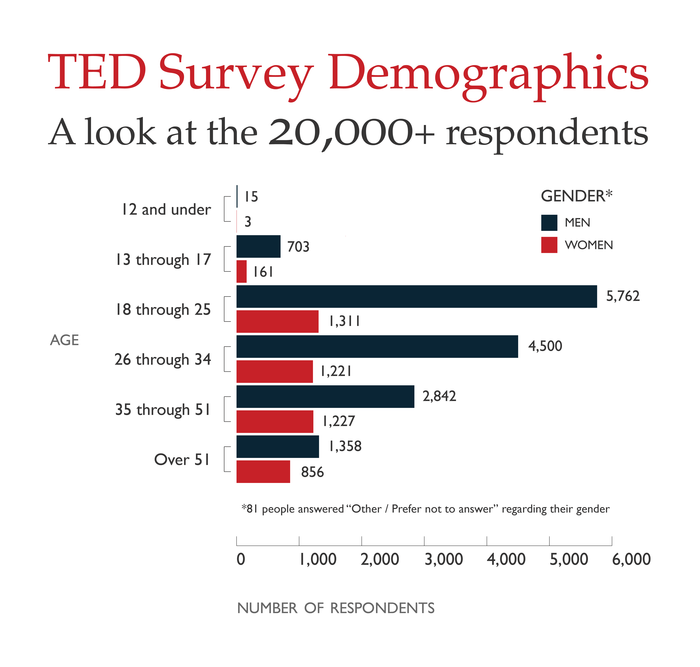
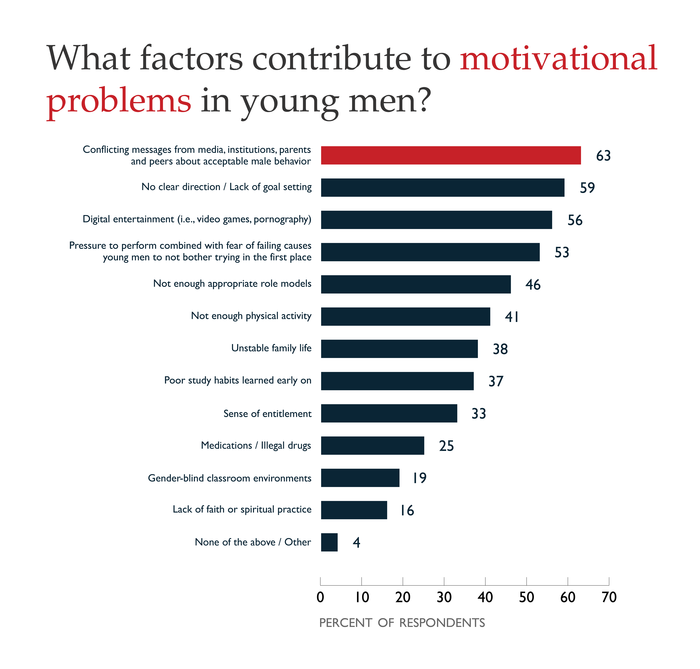
Survey highlights:
- 64 percent of boys age 12 and younger chose “Pressure to perform combined with fear of failing causes young men to not bother trying in the first place.”
- 62 percent of guys age 13 through 17 chose “Digital entertainment (i.e., video games, pornography).”
- 66 percent of guys age 18 through 25, and
63 percent of guys age 26 through 34, chose “No clear direction/Lack of goal setting.”
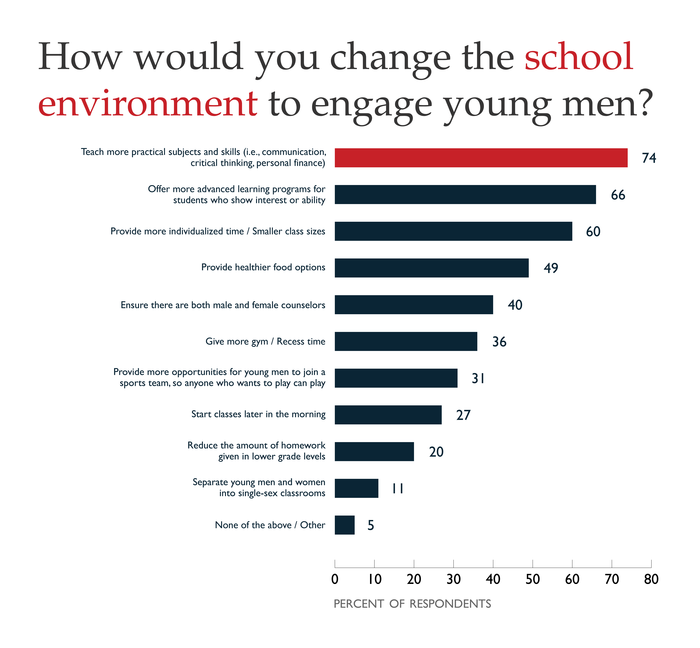
Survey highlights:
- 64 percent of boys age 12 and younger chose “Ensure there are both male and female counselors.”
- 73 percent of guys age 13 through 17 chose “Offer more advanced learning programs for students who show interest or ability.”
- 75 percent of guys age 18 through 34 chose “Teach more practical subjects and skills.”
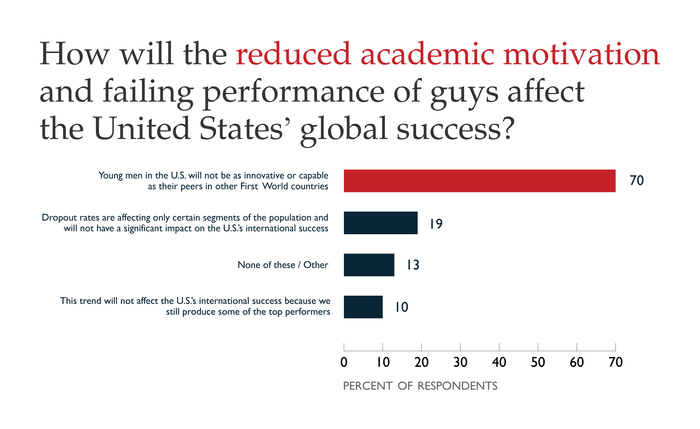
Survey highlights:
The following groups all chose “Young men in the U.S. will not be as innovative or capable as their peers in other First World countries”:
- 65 percent of guys age 13 through 17.
- 66 percent of guys age 18 through 25.
- 75 percent of guys age 26 through 34.
- 74 percent of all respondents age 35 and older.

Survey highlights:
The following groups all chose “Give young men a creative space where they can express themselves”:
- 89 percent of boys age 12 and younger.
- 72 percent of guys age 13 through 17.
- 74 percent of guys age 18 through 25.
- 68 percent of guys age 26 through 34.

Survey highlights:
- 78 percent of boys age 12 and younger chose “Provide a sense of mastery and control.”
- 84 percent of guys age 13 through 17 chose “They’re fun and easily accessible.”
- 85 percent of guys age 18 through 25, and
84 percent of guys age 26 through 34, chose “Provide instant gratification.”
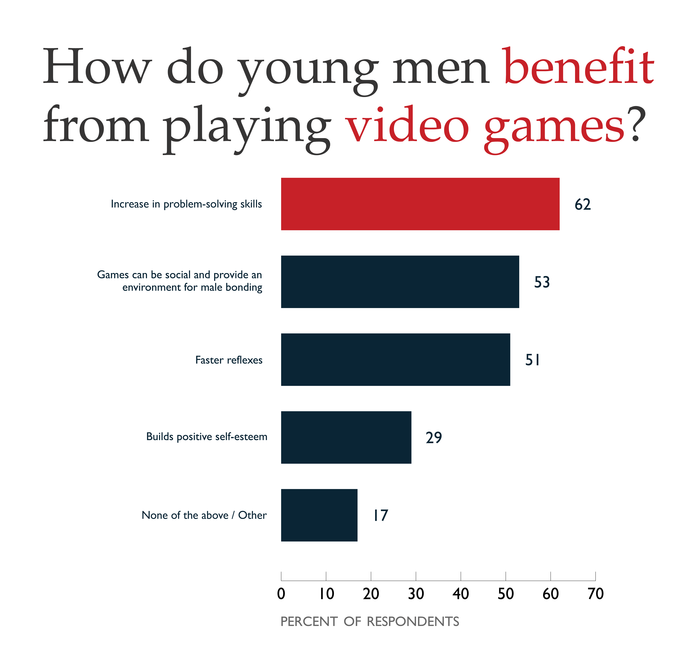
Survey highlights:
- 67 percent of boys age 12 and younger, and
69 percent of guys age 26 through 34, chose “Increase in problem-solving skills.” - 63 percent of guys age 13 through 17 chose “Games can be social and provide an environment for male bonding.”
- 67 percent of guys age 18 through 25, and
69 percent of guys age 26 through 34, chose “Increase in problem-solving skills.”
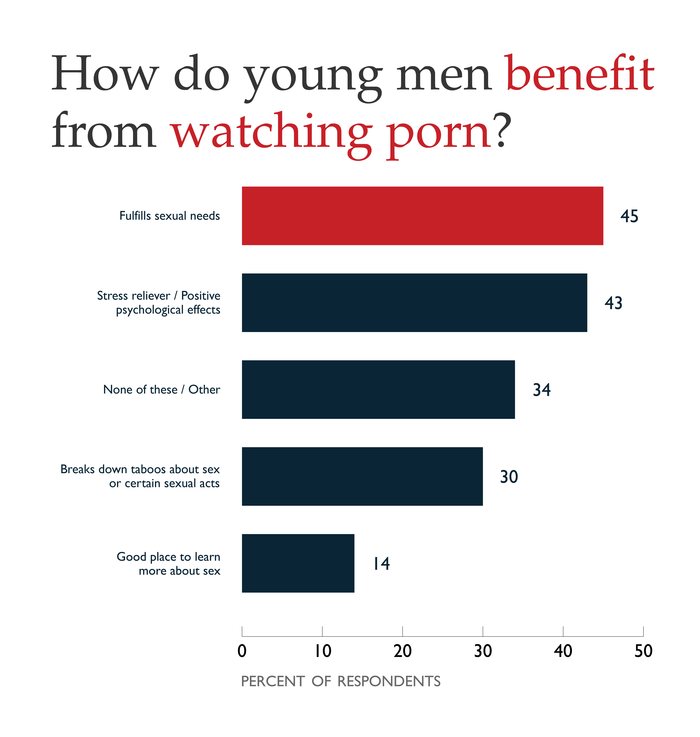
Survey highlights:
- 58 percent of guys age 13 through 17, and
60 percent of guys age 18 through 25, chose “Stress reliever/Positive psychological effects.” - 51 percent of guys age 26 through 34 chose “Fulfills sexual needs.”
- 51 percent of all participants age 35 and older chose “None of the these/Other.”
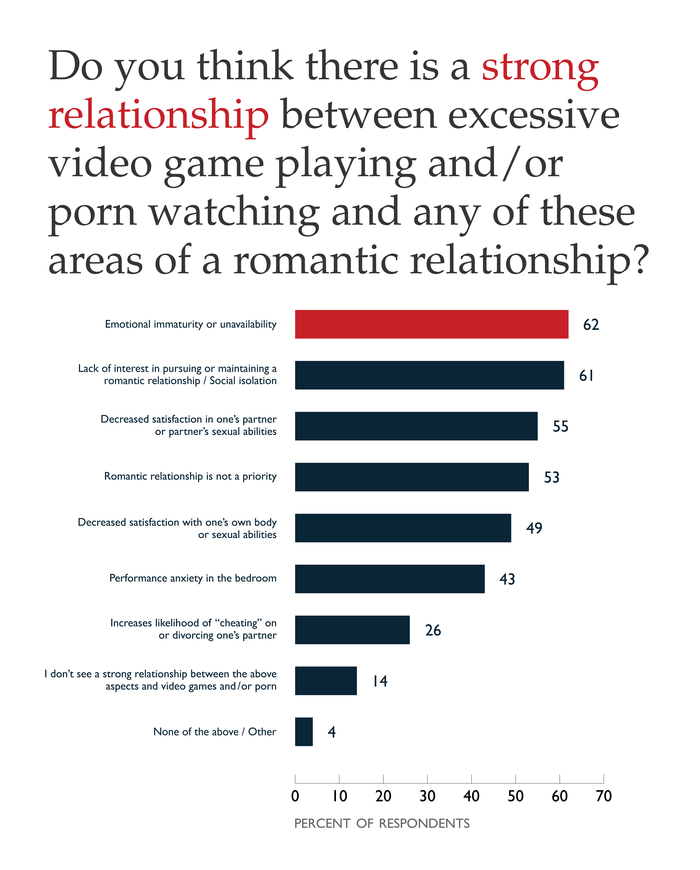
Survey highlights:
- 76 percent of women age 18 through 25, and
78 percent of women age 26 through 34, chose “Emotional immaturity or unavailability.” - 57 percent of guys age 13 through 17,
59 percent of guys age 18 through 25, and
58 percent of guys age 26 through 34 chose “Lack of interest in pursuing or maintaining a romantic relationship/Social isolation.”
Whatever landscape a child is exposed to early on, that will be the sort of gauze through which he or she will see all the world afterwards.
— Wallace Stegner, historian and novelist
Boys haven’t changed a whole lot in recent years, but the environments in which they socialize, go to school, woo girls and mature have. If we take a closer look at their worlds we can better understand what the data that we just reviewed means. In this section we’ll briefly examine the main situational and systemic factors that influence young guys’ thoughts and behaviors, including cultural changes, medication and illegal drug use, social needs, and what’s happening in schools, within families and among peers.
In the film
My Fair Lady
(based on George Bernard Shaw’s play
Pygmalion
), lead actor Rex Harrison has just achieved his successful transformation of a poor flower shop girl into a stunningly beautiful sophisticated lady, played by Audrey Hepburn. When she becomes distressed that he fails to show her any affection or even recognition for all she has done to so dramatically modify her entire being, and perhaps would like a bit of romance as well, he rudely dismisses her. Harrison then sings a song of lament to his buddy, Pickering. Its title is
Why can’t a woman be more like a man?
18
:
Why can’t a woman be more like a man?
Men are so honest, so thoroughly square;
Eternally noble, historic’ly fair;
Who, when you win, will always give your back a pat.
Well, why can’t a woman be like that?
In doing so, he reveals what we believe is actually a common set of attitudes and values held by most men: a deep preference for male company and bonding over association or even mating with women.
This phenomenon is one that Phil has labeled the social intensity syndrome (SIS). The key dimensions of this new view of essential maleness are outlined as follows:
- Men, more than women, are attracted to social settings that involve the ubiquitous presence of a group of other men, over an extended time period.
- That attraction is greater the more intense the nature of the relationship, the more exclusive it is of tolerating “outsiders” or those who have not qualified for that group membership, and the more embedded each man is perceived to be within that group.
- Examples of such social groups are the military — especially during boot camp and deployment — gangs, contact team sports, fraternities, prisons, some cults and neighborhood bars and pubs.
- Men experience a positive arousal — such as cortisol, adrenergic system activation or testosterone increase — when they feel they are part of such all-male social groups.
- Men gradually adapt to that level of social intensity contact as an optimally desired personal and social state.
- Over time, that degree of social intensity becomes a “set point” of desirable functioning, operating at a nonconscious level of awareness.
- Men experience a sense of social isolation and then boredom immediately following their separation from such socially intense male group settings — when having to function in mixed-gender groups or family settings.
- Men may experience withdrawal symptoms when removed from such socially intense group settings; symptoms are greater the longer and more intense the prior duration of their group participation has been.
- Social intensity syndrome is the descriptive term for this complex of values, attitudes and behaviors organized around personal attraction to and subconscious desire to maintain association with these male-dominated social groupings.
And this phenomenon peaks on Super Bowl Sunday, when many guys would rather be in a bar with strangers, watching a totally overdressed Tom Brady, the New England Patriots’ star quarterback, than with a totally naked Jennifer Lopez in their bedroom.
This hidden desire to be part of the “guy thing” is double-edged, though. It must not become too intimate and personal for fear of seeming gay. So that enforces a rule of superficiality and of nontouching other guys, except for high-fives, chest bumping and shots in the arm.
It is possible to generate some interesting predictions of possible behavioral consequences for men with high SIS levels. They will do some or all of the following:
- Respond to the negative effect of disengagement from such groups by engaging in arousing activities, such as high-risk ventures, daring deeds, arguments and fights, drinking to excess, gambling, speeding and similar actions.
- Feel less comfortable having women as friends.
- Spend more time in symbolic male groups, such as watching sports in a sports bar or even engaging in fantasy football or baseball competitions.
- Report high levels of boredom after separating from the socially intense grouping.
- Recall greater positive and fewer negative aspects of one’s time in those male-bonding groups.
- Deal with the arousal deficit by seeking redeployment if in the military.
- Deal with the arousal deficit by hanging around settings where there are likely to be other men who also belong to such high-intensity groupings, such as soldiers hanging around VA hospital lobbies or sports fans becoming team “fanatics.”
- Be more likely to engage in spouse abuse, especially when drinking, and more likely to become divorced or separate from mates with whom they had a positive relationship prior to deployment or team membership.
- Be more likely to develop generally negative attitudes toward women as “the other” who do not understand them, and prefer pornography and sex with prostitutes or erotic massage parlor “therapists” to consensual sexual relationships with equal-status female mates.
Paradoxically, then, males can get such generalized arousal merely from being in the presence of other men in group settings but must avoid showing or even experiencing feelings of intimacy in those associations for fear of being perceived as homosexual or, worse, giving into homosexual impulses. Then when they are presented with the prospect of intimacy with a woman, the opposite response occurs: They may fail to get aroused.
Social intensity syndrome is prevalent worldwide. In Japan, young men are increasingly apathetic to sex. Even married couples have less sex. “Over a third of men ages 16 to 19 had no interest in sex, double the figure from 2008, and over 40 percent of those married have been sexless for at least the past month,”
19
reported the
Japan Times
in a recent article covering research done by Kunio Kitamura of the Clinic of the Japan Family Planning Association. The phenomenon is so common, these men have been given a name: “soshokukei danshi,” or “herbivorous men,” in contrast to carnivorous men, who still perform sex.
One particularly poignant response to our TED survey came from a young male student at Bard College in New York:
I must admit that I haven’t had one real physical relationship in my entire life. I’m a complete extrovert who has a core group of [male] friends along with a whole bunch of other friends [including some women] but has always been rather unsure when it comes to women. I feel like I can’t really interact with them, and end up treating them like men, which makes them my friend but not someone who is a romantic interest. … I would definitely rather hang out with my friends and enjoy the company of a small group of guy friends where we hang out and relax.
